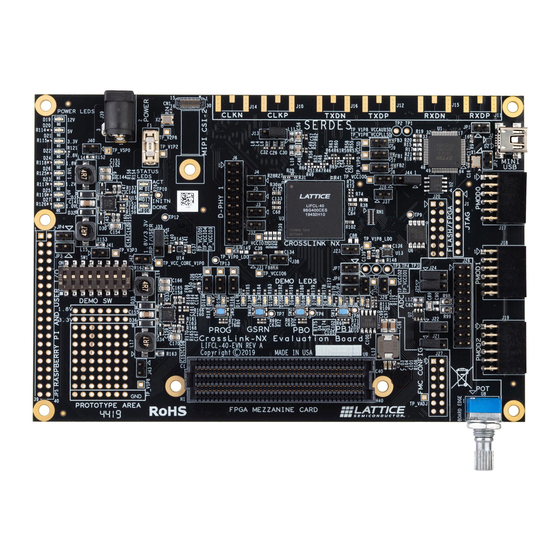
Lattice Semiconductor CrossLink-NX Manuals
Manuals and User Guides for Lattice Semiconductor CrossLink-NX. We have 8 Lattice Semiconductor CrossLink-NX manuals available for free PDF download: User Manual, Quick Start Manual, Quick Start
Lattice Semiconductor CrossLink-NX User Manual (54 pages)
PCIe Bridge Board
Brand: Lattice Semiconductor
|
Category: Network Hardware
|
Size: 3 MB
Table of Contents
Advertisement
Lattice Semiconductor CrossLink-NX User Manual (58 pages)
Brand: Lattice Semiconductor
|
Category: Motherboard
|
Size: 3 MB
Table of Contents
Lattice Semiconductor CrossLink-NX User Manual (46 pages)
PCIe Colorbar Demo for Lattice Nexus-based FPGAs
Brand: Lattice Semiconductor
|
Category: Computer Hardware
|
Size: 2 MB
Table of Contents
Advertisement
Lattice Semiconductor CrossLink-NX User Manual (22 pages)
ROI User Tracking Using VVML Board Demonstration
Brand: Lattice Semiconductor
|
Category: Motherboard
|
Size: 0 MB
Table of Contents
Lattice Semiconductor CrossLink-NX User Manual (18 pages)
Brand: Lattice Semiconductor
|
Category: Motherboard
|
Size: 0 MB
Table of Contents
Lattice Semiconductor CrossLink-NX User Manual (18 pages)
QVGA MobileNet Human Counting Using VVML Board
Brand: Lattice Semiconductor
|
Category: Computer Hardware
|
Size: 1 MB
Table of Contents
Lattice Semiconductor CrossLink-NX Quick Start Manual (15 pages)
Object Counting Using VGG
Brand: Lattice Semiconductor
|
Category: Computer Hardware
|
Size: 1 MB
Table of Contents
Lattice Semiconductor CrossLink-NX Quick Start (2 pages)
Voice and Vision Machine Learning Board
Brand: Lattice Semiconductor
|
Category: Control Unit
|
Size: 0 MB
Table of Contents
Advertisement
Related Products
- Lattice Semiconductor CrossLink-NX ISP Demo
- Lattice Semiconductor CertusPro-NX
- Lattice Semiconductor CertusPro-NX Versa Board
- Lattice Semiconductor CrossLink
- Lattice Semiconductor iCE40 SPRAM Series
- Lattice Semiconductor iCE40 Ultra
- Lattice Semiconductor LatticeMico GPIO
- Lattice Semiconductor LatticeMico32
- Lattice Semiconductor LatticeMico8
- Lattice Semiconductor sysCLOCK ECP5